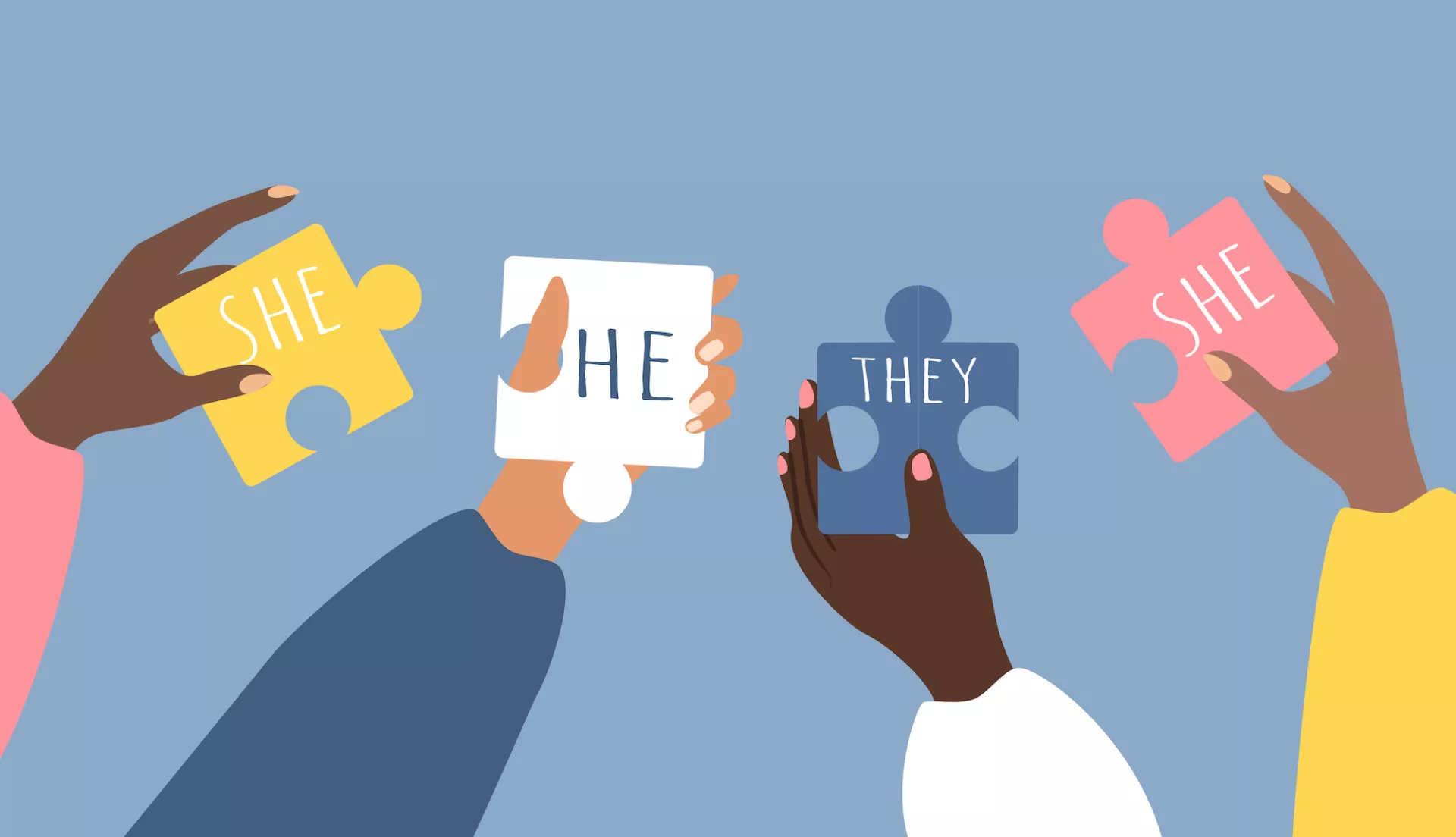Key Takeaways
- Pronouns affirm gender identities and create safe spaces for students, while misgendering results in marginalization and communicates that a person’s identity is not seen as important.
- Learn how to help increase your understanding with answers to some common questions about gender identity.
- NEA offers guidance to ensure safe and welcoming schools, but educators must follow their districts’ policies and state laws. Know your rights.
For Miller Lashbrook, an English and creative writing teacher in Kissimmee, Fla., pronouns are more than just words.
“A simple two-, three-, or four-letter word can empower somebody to take ownership of themselves and their identity,” says Lashbrook, who is genderfluid and uses all pronouns—he, she, and they—meaning Lashbrook identifies with different gender identities at different times.
To help create a better learning environment for students, Lashbrook and another teacher provided a professional development course for their colleagues at Tohopekaliga High School. Topics included pronoun usage, assumptions about sharing pronouns, and best practices for not outing students.
A growing number of educators are seeking out these trainings. The Florida Education Association (FEA), for example, saw a jump in the number of educators who signed up for LGBTQ+ trainings last year.
In the wake of Florida’s new “Don’t Say Gay” law, FEA partnered with the LGBTQ+ advocacy group Equality Florida to strengthen their trainings. “[We wanted to] ensure members have a place to grow and help others do the same,” says Primrose Cameron, FEA’s director of professional development. The union’s goal, she adds, is “to protect our students and educators.” This simple action of acknowledging pronouns can change how students see themselves in their school settings.

According to NEA’s guide to pronouns, social interactions where a person is addressed by the name and pronouns that are consistent with their gender identity are critical to the health and well-being of transgender and gender-diverse people.
Addressing someone by the wrong name or misgendering them, by using incorrect pronouns, can feel disrespectful, harmful, and even threatening to a gender-diverse person. Misgendering results in marginalization and communicates that a person’s identity is not seen as important.
When correct names and pronouns are used, statistics show that suicide rates drop, while trust and feelings of belonging increase. “It’s also a sign of respect,” said Saul Ramos, in June, during an NEA-hosted webinar on pronouns. Ramos is a paraprofessional in Massachusetts and a member of NEA’s Sexual Orientation and Gender Identity Committee.
Embracing these pronouns, however, doesn’t come easily to everyone. Some educators want to be supportive but may feel apprehensive about asking for pronouns—or they may avoid the topic all together for fear of offending someone.
It’s normal to have questions. And the union is one of the best places to find support and answers. Connect with building representatives or local and state affiliates to find out what trainings are available in your area. To help increase your understanding, here are answers to some common questions about gender identity:
Why are pronouns important?
Pronouns affirm gender identities and create safe spaces by referring to people in the way that feels most accurate to them.
Do I have to share my pronouns?
Not everyone is comfortable sharing their pronouns, including transgender, nonbinary, or questioning folks who might not be out yet. Others might object to sharing for any number of personal reasons. Respect those who offer to share their pronouns and those who do not. No one should be forced to comply, as long as they simply skip the practice and do not mock or belittle it.
They/them pronouns are hard for me. What should I know?
The use of the singular “they” can be traced as far back as 1386, in Geoffrey Chaucer’s The Canterbury Tales. Today, plural pronouns are becoming more widely accepted as gender-neutral singular pronouns. It’s grammatically correct to use singular “they” to refer a person of unknown gender or to a nonbinary person who does not feel gendered pronouns work for them.
How do I put pronoun use into practice in the classroom?
Try role modeling your pronouns before inviting everyone to introduce theirs. “Hi, my name is Meg, and I use she/her/ hers pronouns. Could everyone please go around and share their name and pronouns.”
Do only LGBTQ+ people share and use correct pronouns?
No. Pronouns are for everyone. It’s how we identify ourselves.
What if I make a mistake?
Apologize briefly and correct yourself. For example, “And I was saying to someone that he’s a really good—sorry, she—that she was a really good painter.” Don’t over-apologize. Over-apologizing could sound like, “Oh gosh I am so so sorry, I really am. I know it’s wrong, and this must happen all the time. Gosh pronouns are so difficult!” When you over-apologize, you’ve made the moment about your feelings, when pronouns are really about paying attention to the other person.
NEA offers guidance to ensure safe and welcoming schools, but educators must follow their districts’ policies and state laws. Know your rights!
Pronouns 101
| Subjective | Objective | Possessive Adjective | Possessive Pronouns | Reflexive Pronunciation |
|---|---|---|---|---|
| She | Her | Her | Hers | Herself |
| He | Him | His | His | Himself |
| They | Them | Their | Theirs | Themselves |
| Ze | Zim | Zirself, Zay, or Zee | ||
| Zim (rhymes with them) | ||||
| Zir (rhymes with their) |



